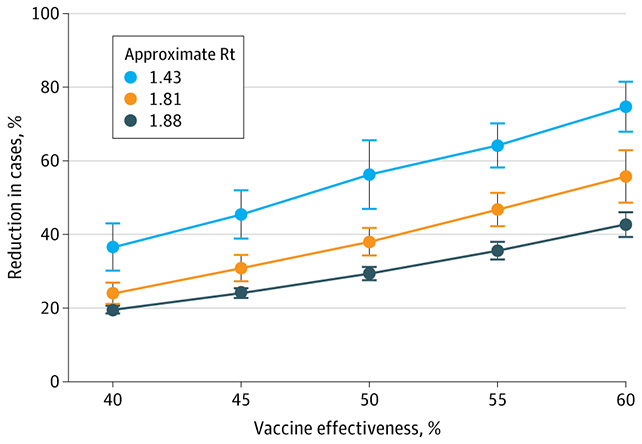A new simulation study shows that higher influenza vaccination rates protect both vaccinated and unvaccinated people from infection – though those who get the jab get the most protection.
Researchers from the University of Pittsburgh ran computer simulations modeling 1.2 million people in a US county. The simulations were set up to measure the day-to-day spread of flu through households, schools, workplaces, and neighborhoods.
The simulations were used to test how a vaccine with 40 percent effectiveness fared in a range of flu seasons with different transmission rates and levels of vaccine uptake. Each simulation was also run 100 times over, with averages worked out from the data.
Related: A Single Vaccine For COVID And The Flu Promises to Be a Big Win For Public Health
Once vaccination rates reached 51 percent of the population, total flu cases were reduced by 32.9 to 41.5 percent, depending on the severity of the flu. Benefits were seen in vaccinated people, and to a lesser extent unvaccinated people too.
"For viral strains similar to ones circulating during seasonal influenza, vaccination provided indirect benefit to unvaccinated individuals, but the direct benefit to vaccinated individuals was always greater," write the researchers in their published paper.
In other words, by getting yourself vaccinated, you're giving yourself a significantly better chance of avoiding infection – as well as protecting those around you, even if they haven't been vaccinated.
This is particularly important for people who cannot receive vaccination for medical reasons.

More vaccinated people means fewer infections overall, the study showed. In communities, the subsequent effect is that the vaccinated and unvaccinated alike are exposed to fewer people with disease, and this study helps to quantify that benefit.
However, this shouldn't be used as an excuse for eligible people to skip vaccinations. In the simulations, people who weren't vaccinated had a 43 to 73 percent higher chance of catching the flu, depending on the effectiveness of the vaccine.
What's more, the protection for unvaccinated people was pretty much wiped out in scenarios where the bug spread quickly – as in the early stages of the COVID-19 pandemic. Directly vaccinating as many people as possible is still crucial.
"Even when both vaccine effectiveness and vaccine uptake were low, vaccination showed marked reductions in disease burden for transmission levels characteristic of seasonal influenza," write the researchers.
"However, when the level of transmission was very high, even a highly effective vaccine did not protect unvaccinated individuals."
The study matches up with previous research that shows how vaccinated groups can protect the unvaccinated.
What we can also see in the data here are the limitations of herd immunity: where a population develops sufficient resistance to an infection, through natural immunity or vaccinations, that the spread of the infection becomes limited, helping to protect unvaccinated people. That indirect protection isn't enough for fast-spreading pathogens.
Time and time again the stats have shown that vaccinations reduce preventable deaths, and this latest research adds to that pile of evidence – which is worth highlighting as childhood vaccination rates are declining in some parts of the world.
"Vaccination is the safest and most effective way to prevent infectious diseases," write the researchers. "It not only reduces disease in the vaccinated portion of a population but also potentially provides indirect benefit to the unvaccinated portion."
The research has been published in JAMA Network Open.
